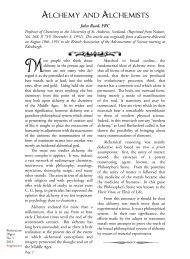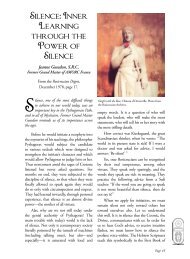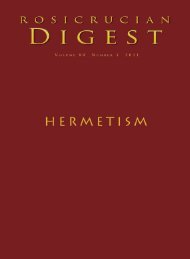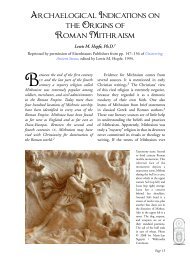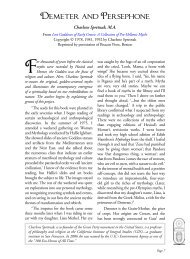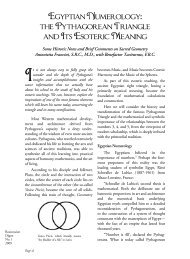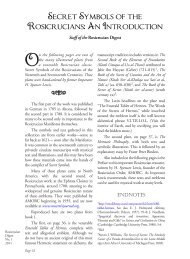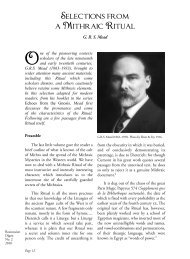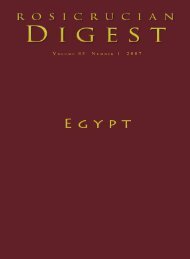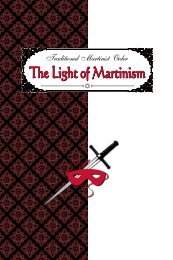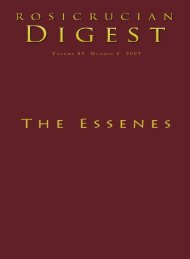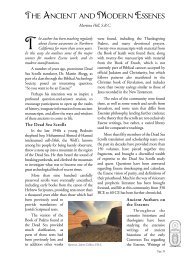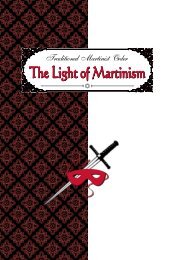Pythagorean Teachings across the Centuries - Rosicrucian Order
Pythagorean Teachings across the Centuries - Rosicrucian Order
Pythagorean Teachings across the Centuries - Rosicrucian Order
Create successful ePaper yourself
Turn your PDF publications into a flip-book with our unique Google optimized e-Paper software.
<strong>Rosicrucian</strong><br />
Digest<br />
No. 1<br />
2009<br />
Jacopo de’ Barbari (?), Ritratto di Frà Luca Pacioli, 1495,<br />
Naples, Museo e Gallerie di Capodimonte. Luca Pacioli<br />
is <strong>the</strong> central figure. The table is filled with geometrical<br />
tools: slate, chalk, compass, a dodecahedron model. A<br />
rhombicuboctahedron (an Archimedean solid, with eight<br />
triangular and eighteen square faces) half-filled with water,<br />
is hanging in <strong>the</strong> air.<br />
<strong>Pythagorean</strong> school. Marsilio Ficino recognized<br />
<strong>the</strong> influence of Pythagoras on Plato.<br />
Giordano Bruno taught that “<strong>the</strong> world<br />
of Pythagoras is better and more pure than<br />
that of Plato.” 33 Tommaso Campanella<br />
lovingly studied Pythagoras and was<br />
accustomed to introducing himself as a<br />
follower of <strong>the</strong> tradition. 34 Fur<strong>the</strong>rmore,<br />
Campanella considered Galileo as <strong>the</strong> one<br />
who was able to resurrect <strong>the</strong> glory of <strong>the</strong><br />
<strong>Pythagorean</strong>s in <strong>the</strong> scientific field. Even<br />
Leonardo da Vinci referred to <strong>the</strong>m in his<br />
studies and research.<br />
One of Leonardo’s collaborators, Fra Luca<br />
Bartolomeo de Pacioli (ca. 1446-1517) was<br />
an Italian ma<strong>the</strong>matician and Franciscan friar.<br />
He drew on <strong>the</strong> earlier work by <strong>the</strong> painter<br />
and ma<strong>the</strong>matician Piero della Francesca<br />
(ca. 1415-October 12, 1492), whose work<br />
he incorporated into his own writings.<br />
Pacioli instructed Leonardo in<br />
ma<strong>the</strong>matics and geometry, and Leonardo<br />
illustrated Pacioli’s reworking of della<br />
Francesca’s Short Book on <strong>the</strong> Five Regular<br />
Solids, which Pacioli expanded and<br />
published in 1509 as De Divina Proportione<br />
(On <strong>the</strong> Divine Proportion): “The subject<br />
was ma<strong>the</strong>matical and artistic proportion,<br />
Page xxxvi<br />
especially <strong>the</strong> ma<strong>the</strong>matics of <strong>the</strong> golden<br />
ratio and its application in architecture.” 35<br />
There can be no doubt that <strong>the</strong><br />
<strong>Pythagorean</strong> mystical tradition was certainly<br />
among <strong>the</strong> major influences on <strong>the</strong>se<br />
Renaissance geometers. Their work connects<br />
<strong>the</strong> ancient world and more modern scholars<br />
such as Schwaller de Lubicz. Pacioli describes<br />
<strong>the</strong> heritage <strong>the</strong> Renaissance had received<br />
from <strong>the</strong> ancient sages and initiates:<br />
“The Ancients, having taken into<br />
consideration <strong>the</strong> rigorous construction of<br />
<strong>the</strong> human body, elaborated all <strong>the</strong>ir works,<br />
as especially <strong>the</strong>ir holy temples, according<br />
to <strong>the</strong>se proportions; for <strong>the</strong>y found here<br />
<strong>the</strong> two principal figures without which<br />
no project is possible: <strong>the</strong> perfection of <strong>the</strong><br />
circle, <strong>the</strong> principle of all regular bodies, and<br />
<strong>the</strong> equilateral square.” 36<br />
Later <strong>Pythagorean</strong> Influences<br />
In <strong>the</strong> eighteenth century, some<br />
astronomers reviewed <strong>the</strong> <strong>Pythagorean</strong><br />
teachings, and attributed to <strong>the</strong>m <strong>the</strong><br />
concept that <strong>the</strong> planet was round, and <strong>the</strong><br />
heliocentric <strong>the</strong>ory. In <strong>the</strong> second half of <strong>the</strong><br />
previous century, <strong>the</strong> “Boëthian Question”<br />
had emerged, related to <strong>the</strong> <strong>Pythagorean</strong><br />
teachings in <strong>the</strong> field of ma<strong>the</strong>matics. This<br />
last deserves to be more extensively explored<br />
as an example of how little we know about<br />
<strong>the</strong> great mystical and initiatic <strong>Pythagorean</strong><br />
tradition.<br />
This question arose from a discovery<br />
by <strong>the</strong> seventeenth century historian and<br />
bibliophile Isaac Vossius while he was reading<br />
a passage of <strong>the</strong> Geometry of Boëthius in<br />
Comparison between five different styles of writing Arabic<br />
numerals, ©2006 by Madden/Wikimedia Commons.




